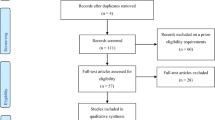Abstract
Background
Currently, little is known about the implicit evaluations that cancer survivors have for health behaviors, such as eating fruits and vegetables. Understanding both the implicit and explicit evaluations of fruit and vegetable consumption among cancer survivors may aid future interventions for changing motivations and intentions in this higher risk population.
Methods
A cross-sectional study at a university cancer center assessed explicit and implicit evaluations of fruit and vegetable consumption among 122 cancer survivors. The explicit evaluations regarding fruit and vegetable consumption were self-report data. To obtain implicit evaluations, participants completed an implicit evaluation task, the Affect Misattribution Paradigm. Moderating variables of time since first cancer treatment and if participants had a prior cancer occurrence were also self-reported.
Results
Simple correlations found no significant association between the implicit and explicit evaluations of fruit and vegetable consumption. Moderation regression analyses showed that the implicit and explicit evaluations became negatively associated as time since first treatment increased and when participants had a prior cancer occurrence.
Conclusion
The results support the view that implicit and explicit measures of fruit and vegetable consumption diverge for cancer survivors, consistent to implicit and explicit evaluations in other domains and samples. Further, the association between these evaluations differed depending on time since first treatment and if they have been treated for a prior cancer occurrence. By knowing more about implicit and explicit positive evaluations, and their moderators, it may be possible for interventionists to alter cancer survivors’ motivation and intention to eat fruits and vegetables.

Similar content being viewed by others
References
Protani M, Coory M, Martin JH. Effect of obesity on survival of women with breast cancer: systematic review and meta-analysis. Breast Cancer Res Treat. 2010;123:627–35.
National Cancer Institute. Cancer trends. 2016. Available from: https://progressreport.cancer.gov/after/obesity. Accessed 30 Aug 2018.
Gery P, Guy K Jr, Yabroff R, Ekwueme DU, Hee Rim S, Li R, et al. Economic burden of chronic conditions among survivors of cancer in the United States. J Clin Oncol. 2017;35:2053–61.
Bazzano LA, He J, Ogden LG, Loria CM, Vupputuri S, Myers L, et al. Fruit and vegetable intake and risk of cardiovascular disease in US adults: the first national health and nutrition examination survey epidemiologic follow-up study. Am J Clin Nutr. 2002;76:93–9.
American Cancer Society. Can I do anything to prevent cancer recurrence? 2016. Available from: https://www.cancer.org/treatment/survivorship-during-and-after-treatment/understanding-recurrence/can-i-do-anything-to-prevent-cancer-recurrence.html. Accessed 1 Nov 2017.
Zhang FF, Liu S, John EM, Must A, Denmark-Wahnefried W. Diet quality of cancer survivors and noncancer individuals: results from a national survey. Cancer. 2015;121:4212–21.
Ajzen I. The theory of planned behavior. Organ Behav Hum Decis Process. 1991;50:179–211.
Walsh EM, Kiviniemi MT. Changing how I feel about the food: experimentally manipulated affective associations with fruits change fruit choice behaviors. J Behav Med. 2014;37:322–31.
Ellis EM, Kiviniemi MT, Cook-Cottone C. Implicit affective associations predict snack choice for those with low, but not high levels of eating disorder symptomatology. Appetite. 2014;7:124–32.
Greenwald AG, Banaji MR, Nosek BA. Statistically small effects of the Implicit Association Test can have societally large effects. J Pers Soc Psychol. 2015;108:553–61.
Payne BK, Cheng CM, Govorun O, Stewart BD. An inkblot for attitudes: affect misattribution as implicit measurement. J Pers Soc Psychol. 2005;89:277–93.
Stacey FG, James EL, Chapman K, Courneya KS, Lubans DR. A systematic review and meta-analysis of social cognitive theory-based physical activity and/or nutrition behavior change interventions for cancer survivors. J Cancer Surviv. 2015;9:305–38.
Karpinski A, Steinman RB, Hilton JL. Attitude importance as a moderator of the relationship between implicit and explicit attitude measures. Personal Soc Psychol Bull. 2005;31:949–62.
Nosek BA. Implicit-explicit relations. Curr Dir Psychol Sci. 2007;16:65–9.
Perugini M. Predictive models of implicit and explicit attitudes. Brit J Soc Psychol. 2005;1:29–5.
Castelli L, Carraro L, Gawronski B, Gava K. On the determinants of implicit evaluations: when the present weighs more than the past. J Exp Soc Psychol. 2010;46:186–91.
Mullens AB, McCaul KD, Erickson SC, Sandgren AK. Coping after cancer: risk perceptions, worry, and health behaviors among colorectal cancer survivors. Psycho-Oncology. 2004;13:367–76.
Payne K, Lundberg K. The affect misattribution procedure: ten years of evidence on reliability, validity, and mechanisms. Soc Personal Psychol Compass. 2014;8:672–86.
Spring VL, Bulik CM. Implicit and explicit affect toward food and weight stimuli in anorexia nervosa. Eat Behav. 2014;15:91–4.
Boardley D, Murray, AB, Van Wasshenova E, Mahas R, Tull M, Tipton J, Geers AL. Predictors of fruit and vegetable consumption among cancer survivors. 2018.
Kanera IM, Bolman CA, Mesters I, Willems RA, Beaulen AA, Lechner L. Prevalence and correlates of healthy lifestyle behaviors among early cancer survivors. BMC Cancer. 2016;16:4.
Satia JA, Campbell MK, Galanko JA, James A, Carr C, Sandler RS. Longitudinal changes in lifestyle behaviors and health status in colon cancer survivors. Cancer Epidemiol Prev Biomark. 2004;13:1022–31.
Egloff B, Schmukle S. Gender differences in implicit and explicit anxiety measures. Pers Individ Differ. 2004;36:1807–15.
Author information
Authors and Affiliations
Corresponding author
Ethics declarations
Conflict of Interest
The authors declare that they have no conflict of interest.
Ethical Approval
All procedures performed in studies involving human participants were in accordance with the ethical standards of the University of Toledo Social, Behavioral and Educational IRB committee (IRB approval number: 200799), the guidelines of the American Psychological Associations, and with the 1964 Helsinki Declaration and its later amendments.
Additional information
Publisher’s Note
Springer Nature remains neutral with regard to jurisdictional claims in published maps and institutional affiliations.
Rights and permissions
About this article
Cite this article
Maras, J., Murray, A.B., Boardley, D. et al. Assessing the Relationship Between Implicit and Explicit Evaluations of Fruit and Vegetable Consumption by Cancer Survivors. Int.J. Behav. Med. 26, 365–371 (2019). https://doi.org/10.1007/s12529-019-09792-5
Published:
Issue Date:
DOI: https://doi.org/10.1007/s12529-019-09792-5




